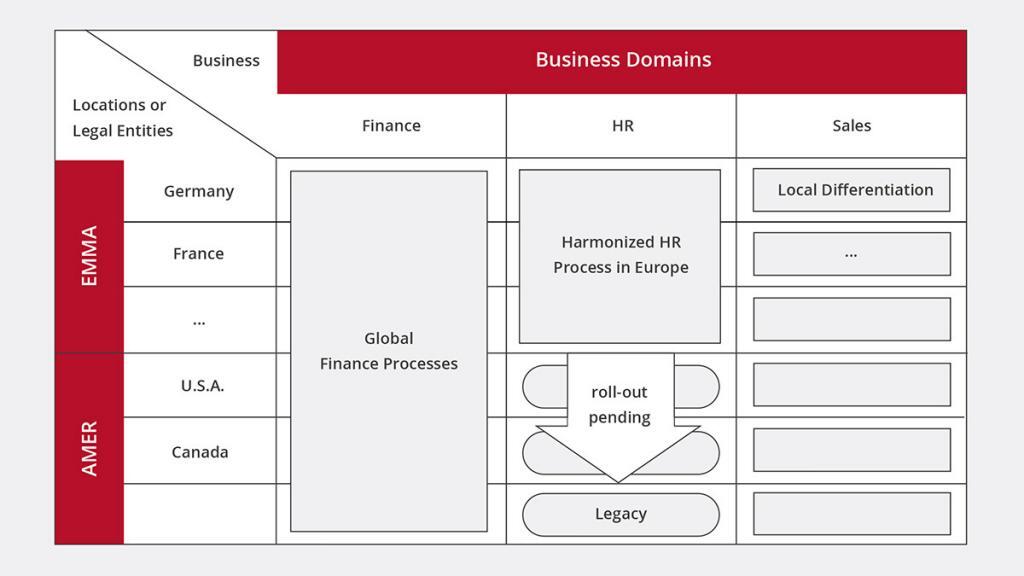As a company’s size increases, so do its requirements for the demand management of an IT organization. IT leaders are faced with the task of providing demand management that consider local differentiation and overall efficiency as well as a stable operation. We address this balancing act with an adaptive demand management that differentiates where necessary and standardizes where possible.
Table of Contents
Demand Management Needs to be Adaptive
Corporate growth, internationalization, and increasing market dynamics influence how corporate IT is organized. At the same time, progressively more IT is moving into products, and services are becoming more digitalized. For instance, modern household appliances and vehicles are of limited use without a cloud connection. The result is that product IT and corporate IT are merging in many areas. In addition to quickly-required innovations, stable operation must also be guaranteed at all times. Thus, corporate IT is faced with an increasing speed of change.
Various IT management areas must adequately address this speed of change. Demand management is one such area. However, demand management faces this dilemma: global control structures promise stable and efficient operation on the one hand, but differentiating structures are required on the other. It is often not possible to adopt one approach for the entire organization. Especially when IT acts as a differentiating factor, a one-size-fits-all approach falls short of achieving competitive advantages. A one-size-fits-all demand management quickly becomes a one-size-fails-all approach.
IT leaders must provide demand management that adapts to the needs of each business area so that they can implement the right solutions efficiently, even in a dynamic world.
Towards Managing Adaptive Demand Management
As a company’s size increases, so do its requirements for the demand management of an IT organization. A small company with manageable process complexity can still accept demands and handle them bilaterally, on demand, since they prioritize and implement requirements locally. However, with increasing size, complexity, and global operation, a company’s need for governance in the demand process increases in order to ensure stable, cost-efficient operation and to reliably organize further development in the company with a coordinated business outcome in line with their strategy.
For this purpose, IT leaders pool capacities, budgets, and demands and assign clear responsibilities to these pools. To assign responsibilities, they must create a tangible, well-defined plan. This plan includes various structures and their meaningful interaction, such as area-related and cross-area demand streams, the categorization of demands that ensure ongoing operations, and strategic topics and transformation initiatives. To achieve this end, we define an adaptive demand portfolio.
A key element in defining an adaptive demand portfolio is identifying the required degree of differentiation and the possible degree of standardization for the different areas of the company.
Efficiency vs. Differentiation in Demand Management
Efficiency and differentiation are two old acquaintances when it comes to strategically aligning the IT organization. This pair comes with familiar characteristics; while efficiency is achieved via centralization and is the means of choice to minimize variance, differentiation is achieved via decentralization and serves primarily to promote rapid growth, foster variance (and thus potentially increase the degree of innovation), and above all increase adaptability to local conditions.
Above a certain company size, IT leaders are faced with the question of which parts of the IT organization should be managed with an eye to efficiency or differentiation.
Is it a product/service that needs to be delivered globally in an efficient manner, using a few standardized channels? A game in an app store is certainly a prime example here, as it requires a high degree of standardization, clear language localization, and uniform monetization. Further development is centrally controlled and affects everyone.
Services that are tailored to regional needs, on the other hand, are difficult to manage centrally. For example, shopping behaviors in Arab countries may be different than shopping behaviors in the United States. The likelihood of regional demands and ratings is increasing.
On the surface, an IT organization benefits from answering the question about differentiation and efficiency in relation to a company‘s particular core business; if the core business is heavily dependent on local conditions — for example for marketing or legal reasons — IT leaders tend to set up their IT organization in a differentiated and decentralized manner. If the core business is less dependent on local conditions, IT leaders tend to take an efficiency-driven, centralized approach. The local speed of change in IT requirements and the required reaction speed are crucial here.
In reality, a mixed approach is taken, centralizing where possible and decentralizing where necessary. Figure 1 shows the general decision paths to consider when designing your own demand portfolio.

Create Your Own Adaptive Demand Management
he fundamental consideration in demand management is the evaluation, prioritization, and provision of a suitable supply channel. This is also the most important factor for setting the right guard rails.
As it moves into corporate IT, the issue of whether global standardized delivery processes are good enough becomes more important. Delivery processes can be operated inexpensively once they have been provided. Of course, global process owners in the business units must also enable standardization. As long as each country is allowed to establish its own sales and service processes, standardization will be possible at the platform level, but not at the process level.
Using the general decision paths (see Figure 1), we can align and meaningfully manage our business domains and legal entities in a single adaptive demand portfolio. Figure 2 shows a simplified example of a corresponding portfolio structure.
For each intersection of the portfolio matrix in Figure 2, senior business management and IT decision-makers must jointly determine whether the local legacy should remain in place for the time being, whether it is possible to establish global harmonization, or whether local differentiation can be enabled as part of the overall management process.

Legacy
Demand management in „legacy mode“ describes a locally-grown control of demand management that is not harmonized with the company‘s IT. Therefore, the possible variance in demand management and the associated effects on architecture and processes are accordingly high. You can find anything on these legacy islands, from bilateral and unstructured communication via calls, e-mails, or hallway conversations, to ticket systems and local demand management solutions.
The need to integrate these islands into a global management process usually comes from two directions: either the organization locally grows faster than requirements can be implemented in sufficient quality, or they launch an initiative to achieve global demand management, often in conjunction with the goal of harmonizing technology landscapes and processes.
Local Differentiation
Organizations choose local differentiation when the competitive advantage gained through local control is greater than the increased efficiency possible through harmonization. This is often the case in sales and marketing, for example, or wherever local regulations and laws make differentiation mandatory.
Local differentiation means that clear local responsibilities (known at the global level) as well as budget and capacity limits are incorporated into demand management. Overall, entities establish a regulated process in which they make global demands transparent, but handle budget authority, allocation of capacities, and prioritization locally.
Global Harmonization
Global harmonization primarily focuses on the portfolio from the perspective of the business domains. The focus is thus on management from a vertical perspective across various legal entities, countries, and regions. The global process owner has budget sovereignty, can provide capacities from a central location for planning purposes according to the rules, and can therefore prioritize the demands (in figure 2, for example: Finance HR). As with local differentiation, the transparency here is also bi-directional, which means that demands, prioritizations, and results are transparent at both local and global levels. Since business domains compete company-wide at the global level, regular coordination meetings become necessary, which we will discuss in more detail in the following chapter, Executing Adaptive Demand Management.
Executing Adaptive Demand Management
The basic rules for demand management are relatively straightforward. When prioritizing demands in the portfolio, managers must prioritize topics that maintain operations first. Only then is it possible to implement growth and transformation topics without risking losses.
The designated managers of the legal entities and business domains must establish a dialog and define corresponding prioritizations in a regular process. Depending on the portfolio structure, the local units or the global process owner take the lead.
Such a coordination process usually takes place quarterly and is based on a transparent overview of capacities and available budgets. In highly agile scenarios, a three-month cycle can possibly lead to coordination congestion, and more importantly, unnecessary overhead. This congestion and overhead can be effectively counteracted by raising the value thresholds. Increasing the lower value threshold for demands leads to smaller topics being able to quickly enter implementation without overhead, while managers can prioritize larger topics at the quarterly meetings. It is important to note that smaller topics continue to be assigned to the appropriate responsibilities so that they remain controllable. Only the approval process changes here.
A common pitfall to defining and adjusting thresholds lies in over-structuring. Some organizations tend to introduce complex scoring here once they have taken this path of definition. As a result, they create a calculation process based on a wide variety of factors, which has little to do with reality due to its rather mathematically-motivated character. This tactic creates unnecessary overhead, and ends up being discarded in the long run due to its ineffectiveness.
In addition to the three basic options presented above for cutting an adaptive demand portfolio (legacy, local, global), other options also exist, such as cutting according to strategic initiatives or product portfolios. The strategic initiatives are controlled top-down and take precedence over other topics.
For product portfolios, management is usually bottom-up and cross-domain. This type of management is partly due to the proximity of those responsible to the product(s) and partly due to the fact that the „operations first“ rule can only apply indirectly here, as product portfolios combine operational, growth, and transformation topics. Here, the corresponding prioritization must take place separately at the product level and is the result of coordination between product portfolio managers, product managers, and — in the digital area — the interdisciplinary teams or DevOps teams.
What Does Your Demand Management Look Like?
We are happy to answer this question with you. Based on our holistic IT management platform Bee360, we work out the portfolio cut that is right for you, and together we establish the associated governance mechanisms in your organization. Whether it is the integration of legacy into a global management, the harmonization of process and technology landscapes, the analysis of where differentiation makes sense and to what degree, a new cut along changed responsibilities and goals, the integration of product portfolios, the manifestation and steering of strategic initiatives, or simply the more efficient and robust execution of existing demand management, we look forward to tackling these and other challenges together with you.

Dr. Corvin Meyer-Blankart
Dr. Corvin Meyer-Blankart

